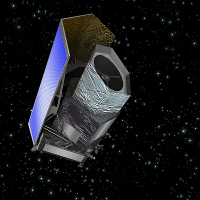Dark Universe mission blueprint complete
20 June 2012
ESA's Euclid mission to explore the hidden side of the Universe - dark energy and dark matter - reached an important milestone today that will see it head towards full construction.
 |
|
Artist's impression of Euclid Credit: ESA/C. Carreau |
Selected in October 2011 alongside Solar Orbiter as one of the first two medium-class missions of the Cosmic Vision 2015-25 plan, Euclid received final approval from ESA's Science Programme Committee to move into the full construction phase, leading to its launch in 2020.
The committee also formalised an agreement between ESA and funding agencies in a number of its Member States to develop Euclid's two scientific instruments, a visible-wavelength camera and a near-infrared camera/spectrometer, and the large distributed processing system needed to analyse the data they produce.
Finally, the committee agreed on a Memorandum of Understanding between ESA and NASA that will see the US space agency help to provide infrared detectors.
Nearly 1000 scientists from 100 institutes form the Euclid Consortium building the instruments and participating in the scientific harvest of the mission.
"This formal adoption of the mission is a major milestone for a large scientific community, their funding agencies and also for European industry," said Alvaro Giménez Cañete, ESA's Director of Science and Robotic Exploration.
"It took a lot of hard work to get this far, but we now have a solid blueprint for a feasible space telescope which enables very accurate measurements that will bring to light the nature of dark energy," said Yannick Mellier, the Euclid Consortium lead.
In the coming months, industry will be asked to make bids to supply spacecraft hardware, such as the telescope, power systems, attitude and orbit controls, and communications systems.
Euclid will use a 1.2-m diameter telescope and the two instruments to map the 3D distribution of up to two billion galaxies and dark matter associated with them, spread over more than one third of the whole sky.
Stretched across ten billion light-years, the mission will plot the evolution of the Universe's structure over three-quarters of its history.
Euclid is optimised to answer one of the most important questions in modern cosmology: why is the Universe expanding at an accelerating rate, rather than slowing down due to the gravitational attraction of all the matter in it?
The discovery of this cosmic acceleration in 1998 was rewarded with the Nobel Prize for Physics in 2011 and yet we still do not know what causes it.
The term 'dark energy' is often used to signify this mysterious force, but by using Euclid to study its effects on the galaxies and clusters of galaxies across the Universe, astronomers hope to come much closer to understanding its true nature and influence.
"Euclid addresses the cosmology-themed questions of ESA's Cosmic Vision and it's fantastic that we are moving forward into the next stage of development - we're one step closer to learning more about the Universe's darkest secrets," said René Laureijs, ESA's Euclid project scientist.
Notes for Editors
The Euclid Consortium comprises more than 100 laboratories from 13 European countries: Austria, Denmark, France, Finland, Germany, Italy, Netherlands, Norway, Spain, Switzerland, Portugal, Romania and the UK. It also includes several US laboratories.
For more information, please contact:
Markus Bauer
ESA Science and Robotic Exploration Communication Officer
Email: markus.bauer![]() esa.int
esa.int
Tel: +31 71 565 6799
Mob: +31 61 594 3 954
René Laureijs
Euclid Project Scientist
Email: rene.laureijs![]() esa.int
esa.int
(This article was originally published on ESA's Space Science Portal.)
